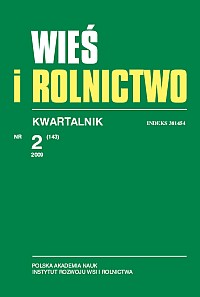Drobne gospodarstwa w rolnictwie polskim. Próba definicji i charakterystyki
Polish agricultures’ small farms. An effort to define this category and its characteristics
Author(s): Włodzimierz DzunSubject(s): Economy
Published by: Instytut Rozwoju Wsi i Rolnictwa Polskiej Akademii Nauk
Keywords: small agricultural holdings; very small area holdings; very small economic strength holdings; self-supply holdings; agricultural production means; agricultural production in small holdings; users of small holdings; balanced agriculture
Summary/Abstract: The papers presents a definition small farms found in the Polish agricultural sector, measuring their size and character against balanced agricultural goals. The sector comprises, according to the 2010 agricultural census, some 1.4 million farms under 5 ha and with a economic size of 4 standard output (SO) or less. This represents 63% of private agricultural holdings in Poland. Although the number of these holdings is diminishing, their share is still very high. Analysis of this group has shown, that majority of these small agricultural holdings do not meet the principal criteria for the balanced development of agriculture, which is to contribute to national food needs in accordance with their area and the size of their production base. Clearly visible is a tendency to decrease an already low level of plant production and resign from animal production on such holdings. As a consequence they are providing fewer real work places, and the share of income from agricultural production in their total income is decreasing. These holdings are characterized also by being low balance with the environment. Primarily they are not sustaining soil productivy. Analysis clearly indicates a cautious approach towards support for small holdings. State help should be linked with clearly defined production and non-production obligations. Such support cannot hamper progress of family farms in terms of area structure, production and economic strength. W artykule podjęto próbę zdefiniowania drobnych gospodarstw rolnych w polskim rolnictwie, określenia ich liczebności oraz dokonania charakterystyki pod kątem realizacji celów rolnictwa zrównoważonego. Przyjmując, że są to gospodarstwa bardzo małe obszarowo (do 5 ha) i bardzo małe ekonomicznie (do 4 SO), stwierdzono, że takich gospodarstw w polskim rolnictwie w 2010 roku było ponad 1,4 mln i stanowiły one 63% ogółu gospodarstw osób fizycznych. Liczba tych gospodarstw znacząco się zmniejsza, ale ich udział pozostaje wciąż bardzo duży. Analiza tej zbiorowości wykazała, że z punktu widzenia zrównoważonego rozwoju zdecydowana większość tych gospodarstw nie spełnia podstawowego wymogu, jakim jest wnoszenie, adekwatnego do posiadanego obszaru użytków rolnych i pozostałych środków produkcji, wkładu w zaspokojenie potrzeb żywnościowych społeczeństwa. W gospodarstwach tych widoczna jest tendencja do obniżania się i tak już niskiego poziomu produkcji roślinnej i wycofywania się z produkcji zwierzęcej. W rezultacie zapewniają one coraz mniej rzeczywistych miejsc pracy, a dochody z produkcji rolniczej w budżetach gospodarstw powiązanych z takimi gospodarstwami stanowią coraz mniejszy udział. Poza tym charakteryzują się one bardzo niskim poziomem środowiskowego zrównoważenia. Przede wszystkim nie realizują tak ważnego zadania, jakim jest utrzymanie potencjału produkcyjnego gleb. Analiza tych gospodarstw wyraźnie wskazuje na konieczność bardzo ostrożnego ich wspomagania ze strony państwa.
Journal: Wieś i Rolnictwo
- Issue Year: 159/2013
- Issue No: 2
- Page Range: 9-27
- Page Count: 19
- Language: Polish

